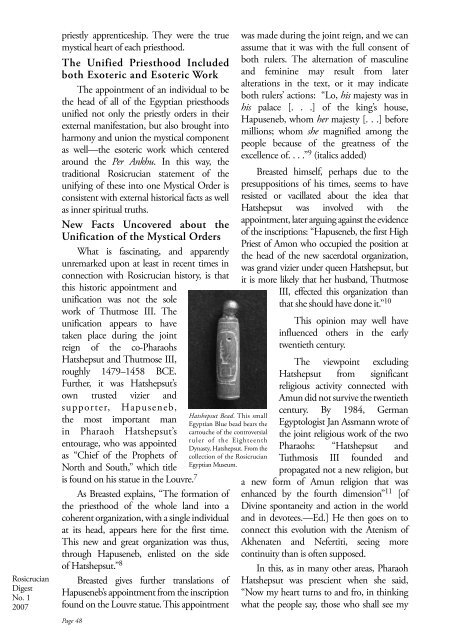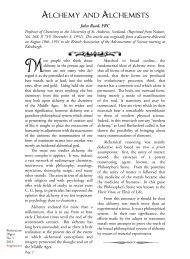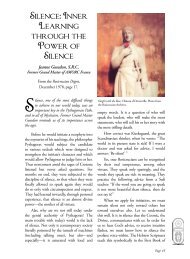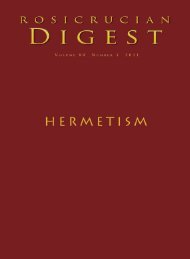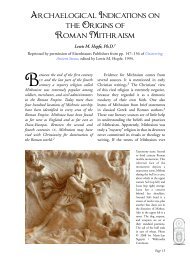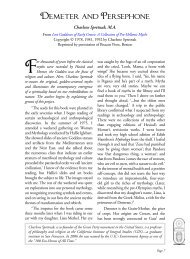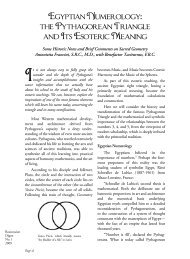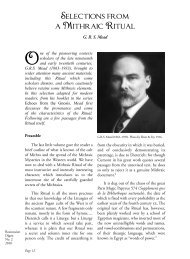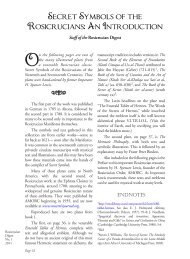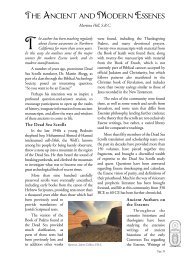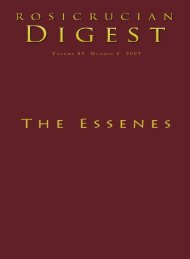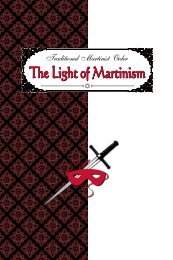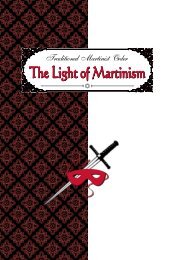Digest - Rosicrucian Order
Digest - Rosicrucian Order
Digest - Rosicrucian Order
Create successful ePaper yourself
Turn your PDF publications into a flip-book with our unique Google optimized e-Paper software.
<strong>Rosicrucian</strong><br />
<strong>Digest</strong><br />
No. 1<br />
2007<br />
priestly apprenticeship. They were the true<br />
mystical heart of each priesthood.<br />
The Unified Priesthood Included<br />
both Exoteric and Esoteric Work<br />
The appointment of an individual to be<br />
the head of all of the Egyptian priesthoods<br />
unified not only the priestly orders in their<br />
external manifestation, but also brought into<br />
harmony and union the mystical component<br />
as well—the esoteric work which centered<br />
around the Per Ankhu. In this way, the<br />
traditional <strong>Rosicrucian</strong> statement of the<br />
unifying of these into one Mystical <strong>Order</strong> is<br />
consistent with external historical facts as well<br />
as inner spiritual truths.<br />
New Facts Uncovered about the<br />
Unification of the Mystical <strong>Order</strong>s<br />
What is fascinating, and apparently<br />
unremarked upon at least in recent times in<br />
connection with <strong>Rosicrucian</strong> history, is that<br />
this historic appointment and<br />
unification was not the sole<br />
work of Thutmose III. The<br />
unification appears to have<br />
taken place during the joint<br />
reign of the co-Pharaohs<br />
Hatshepsut and Thutmose III,<br />
roughly 1479–1458 BCE.<br />
Further, it was Hatshepsut’s<br />
own trusted vizier and<br />
supporter, Hapuseneb,<br />
the most important man<br />
in Pharaoh Hatshepsut’s<br />
entourage, who was appointed<br />
as “Chief of the Prophets of<br />
North and South,” which title<br />
is found on his statue in the Louvre. 7<br />
As Breasted explains, “The formation of<br />
the priesthood of the whole land into a<br />
coherent organization, with a single individual<br />
at its head, appears here for the first time.<br />
This new and great organization was thus,<br />
through Hapuseneb, enlisted on the side<br />
of Hatshepsut.” 8<br />
Breasted gives further translations of<br />
Hapuseneb’s appointment from the inscription<br />
found on the Louvre statue. This appointment<br />
Page 48<br />
Hatshepsut Bead. This small<br />
Egyptian Blue bead bears the<br />
cartouche of the controversial<br />
ruler of the Eighteenth<br />
Dynasty, Hatshepsut. From the<br />
collection of the <strong>Rosicrucian</strong><br />
Egyptian Museum.<br />
was made during the joint reign, and we can<br />
assume that it was with the full consent of<br />
both rulers. The alternation of masculine<br />
and feminine may result from later<br />
alterations in the text, or it may indicate<br />
both rulers’ actions: “Lo, his majesty was in<br />
his palace [. . .] of the king’s house,<br />
Hapuseneb, whom her majesty [. . .] before<br />
millions; whom she magnified among the<br />
people because of the greatness of the<br />
excellence of. . . .” 9 (italics added)<br />
Breasted himself, perhaps due to the<br />
presuppositions of his times, seems to have<br />
resisted or vacillated about the idea that<br />
Hatshepsut was involved with the<br />
appointment, later arguing against the evidence<br />
of the inscriptions: “Hapuseneb, the first High<br />
Priest of Amon who occupied the position at<br />
the head of the new sacerdotal organization,<br />
was grand vizier under queen Hatshepsut, but<br />
it is more likely that her husband, Thutmose<br />
III, effected this organization than<br />
that she should have done it.” 10<br />
This opinion may well have<br />
influenced others in the early<br />
twentieth century.<br />
The viewpoint excluding<br />
Hatshepsut from significant<br />
religious activity connected with<br />
Amun did not survive the twentieth<br />
century. By 1984, German<br />
Egyptologist Jan Assmann wrote of<br />
the joint religious work of the two<br />
Pharaohs: “Hatshepsut and<br />
Tuthmosis III founded and<br />
propagated not a new religion, but<br />
a new form of Amun religion that was<br />
enhanced by the fourth dimension” 11 [of<br />
Divine spontaneity and action in the world<br />
and in devotees.—Ed.] He then goes on to<br />
connect this evolution with the Atenism of<br />
Akhenaten and Nefertiti, seeing more<br />
continuity than is often supposed.<br />
In this, as in many other areas, Pharaoh<br />
Hatshepsut was prescient when she said,<br />
“Now my heart turns to and fro, in thinking<br />
what the people say, those who shall see my


